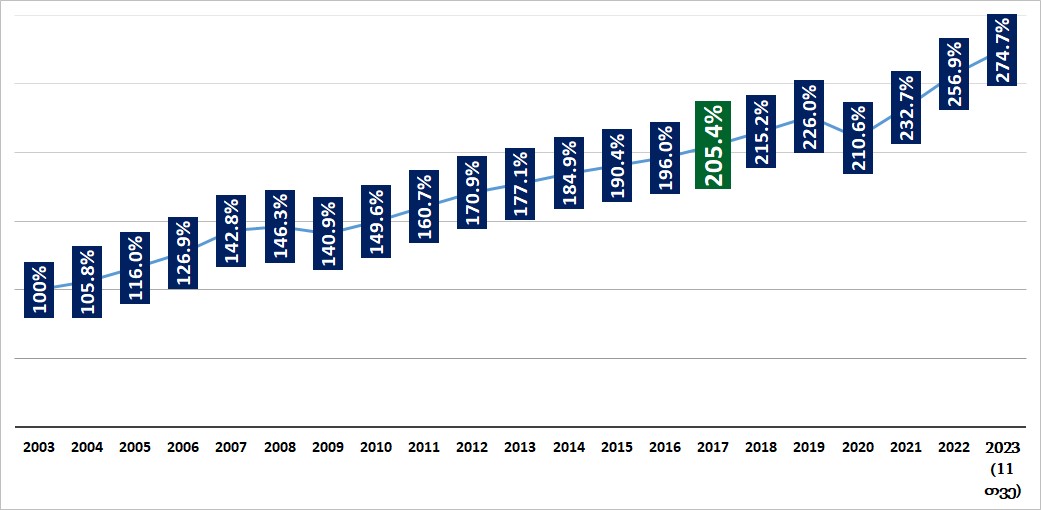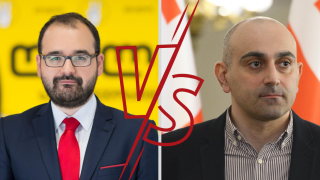Grigol Gegelia: “The GDP is expected to double in four years with a 9% economic growth rate.”
Verdict: FactCheck concludes that Grigol Gegelia’s statement is FALSE.
Sandro Rakviashvili: “The expectation of doubling the GDP in a four-year timeframe with a 9% economic growth is mathematically implausible.”
“It is mathematically implausible for the GDP to double in four years with a 9% economic growth.”
Verdict: FactCheck concludes that Sandro Rakviashvili’s statement is TRUE.
The real GDP is expected to increase by 41% as compared to the base years in four years, driven by a 9% economic growth rate. Hence, it takes twice the duration of eight years for the economy to double at the aforementioned growth rate. Furthermore, achieving a doubled economy within a four-year period requires an annual growth rate of 19% - a scenario that, although theoretically possible, is challenging in practical terms.
Only the nominal economy could potentially double in four years with a 9% growth rate when accounting for inflation (moreover, a higher growth rate may be observed during hyperinflation). However, nominal growth does not necessarily positively influence the prosperity of the country and its population.
Although FactCheck cannot predict the GDP growth rate under the governance of specific political parties in 2025-2028, the statement that the GDP will double with a 9% growth rate in four years is mathematically implausible and false.
Analysis
Members of the Girchi and Lelo political parties engaged in a debate during their appearance on the TV Pirveli show Sajaro Politika (Public Politics) where Grigol Gegelia stated: “We aim to double the economy within the initial four years of our governance … We believe that economic growth rate of at least 9% is needed for that.” Sandro Rakviashvili remarked in response: “Am I not telling you that he struggles with mathematics? What else should I do?”
The dispute commenced upon Lelo’s pledge to raise the old age pension to GEL 1,000. When questioned about how the party plans to achieve this goal, Grigol Gegelia responded by stating their intention to double the economy (currently, the 2024 Georgian budget allocates GEL 3.9 billion for GEL 315 and GEL 415 pensions whilst at least GEL 10 billion would be necessary to meet the GEL 1,000 pension commitment).
The gross domestic product (GDP) is widely regarded as the most optimal method to evaluate a country’s economic condition. Hence, the pace of economic growth is correlated to the GDP growth rate. Typically, developing countries like Georgia have a higher potential for economic growth. Despite the catastrophic downturn in the first half of the 1990s, Georgia’s GDP growth rate has almost always exceeded that of the European Union and the United States of America. However, Georgia’s GDP per capita lags significantly behind considering the base year when compared to the least affluent EU member, Bulgaria.
Georgia exhibited its highest economic growth of 12.6% in 2007 with subsequent double-digit growth rates occurring in 2021 and 2022 at 10.5% and 10.4%, respectively. A comparative analysis between the United National Movement political party’s governance and the Georgian Dream political party’s governance reveals that the average economic growth rate was 6.1% for the years 2004-2012 whereas the period from 2013 to 2023 witnessed an average of 4.4%. The figure prior to the pandemic was 5% in 2019, aligning with the GD’s projected medium-term average of 5.2% for 2024 and 5% for 2025-2027. Combining the UNM and GD governance periods over the last two decades, the average growth rate constitutes 5.2% resulting in a total growth of 175%. The cumulative growth would have been substantially higher at 460%, had the average growth rate been 9%, placing Georgia’s per capita income equal to the current EU average. Theoretically, if the growth rate were 18.9%, the necessary level required for the economy to double in four years, Georgia would surpass Switzerland and become the world’s wealthiest country in terms of GDP per capita. However, it took the economy 14 years to double.
Exceptions do exist where certain economies witnessed growth rates surpassing 19% under specific circumstances. For instance, Guyana’s economy grew by 64% in 2022 attributed to the discovery of new oil fields. Furthermore, despite Fiji experiencing a 20% growth, this figure followed a 4.9% downturn in 2021 and an even larger decline of 17% in 2020. Cabo Verde similarly exhibited high growth rates of 17% but this was in the context of significant contractions of 21% in 2020. In addition to the aforementioned, the Bahamas also experienced a similar scenario. Libya exhibited an 87% growth in 2012, but halved in 2011 due to a civil war, and could not return to its 2010 level even with its substantial growth.
Graph 1: Georgian Economic Growth Dynamics, 2003=100

Source: World Bank
Compound interest should be added to the base year when calculating the GDP growth rate. Using 2024 as the base year, the initial 100 will increase to 109 in 2025, 118.8 in 2026, 125.5 in 2027 and finally 141.2 in 2028.
Mathematics is a precise science. Whether the base figure is 100, a million, a billion or five trillion, the four-year value with a 9% growth rate will be 41% higher than the base figure rather than doubled.
Whilst the aforementioned growth is practically unconvincing but theoretically plausible, a doubling of the economy in four years with a 9% growth is impossible, even theoretically. It would require eight years, or two political terms, rather than one, to accomplish such growth.
Graph 2: Theoretical Scenarios of Economic Growth

On the other hand, calculating the GDP in nominal terms with added inflation could yield even higher growth. However, spending more on expensive goods does not translate to an improvement in the well-being of the population.
Obviously, FactCheck cannot predict the GDP growth rates under the governance of specific political parties from 2025 to 2028. However, the principles of mathematics prevail regardless of election outcomes. Therefore, the economy certainly will not double with a 9% growth rate in four years. Considering that the cumulative growth of 41% falls substantially behind (2.5-fold) as compared to the aforementioned 100%, FactCheck concludes that Grigol Gegelia’s statement is FALSE whereas Sandro Rakviashvili’s statement, in which he refuted such assumptions, is deemed TRUE.








